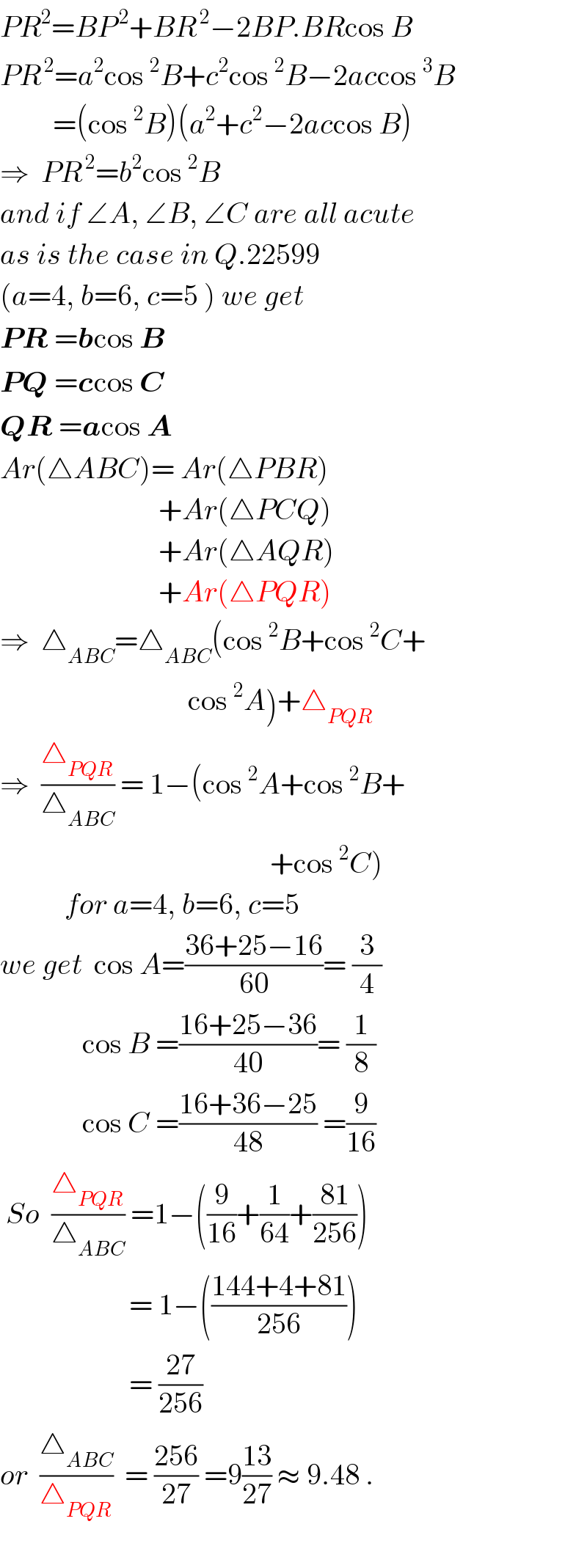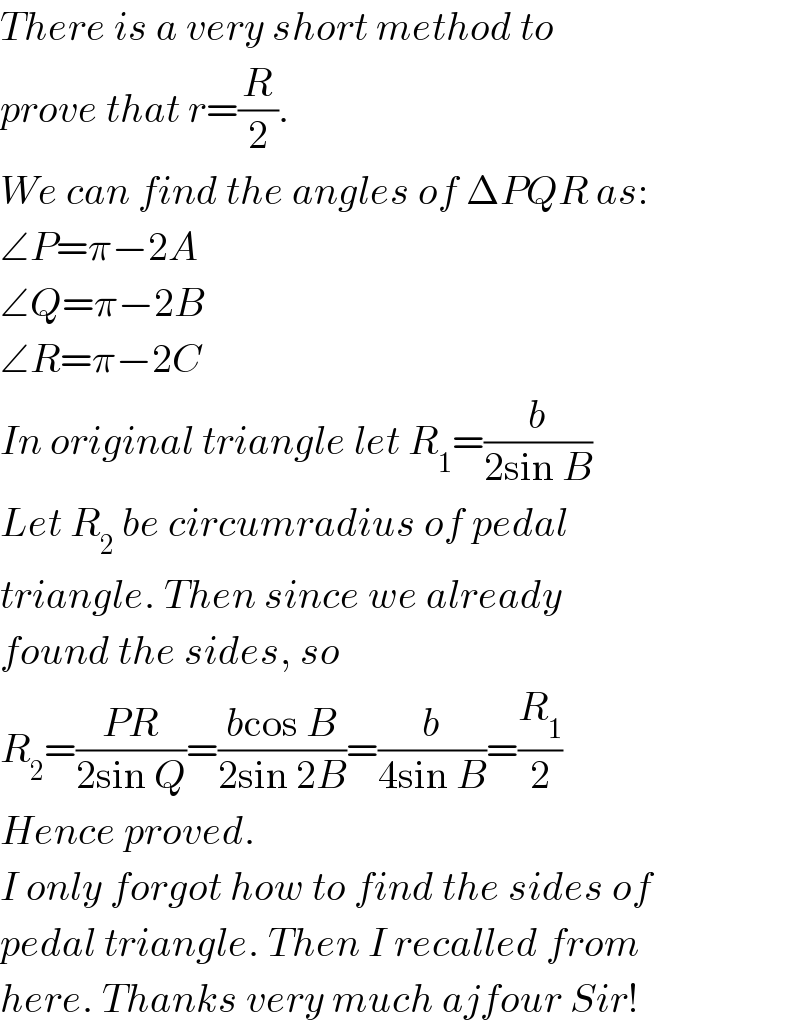
Question Number 22649 by ajfour last updated on 21/Oct/17

Commented by ajfour last updated on 21/Oct/17

$${solution}\:{to}\:{Q}.\mathrm{22599} \\ $$
Answered by ajfour last updated on 21/Oct/17

$${PR}^{\mathrm{2}} ={BP}^{\:\mathrm{2}} +{BR}^{\:\mathrm{2}} −\mathrm{2}{BP}.{BR}\mathrm{cos}\:{B} \\ $$$${PR}^{\:\mathrm{2}} ={a}^{\mathrm{2}} \mathrm{cos}\:^{\mathrm{2}} {B}+{c}^{\mathrm{2}} \mathrm{cos}\:^{\mathrm{2}} {B}−\mathrm{2}{ac}\mathrm{cos}\:^{\mathrm{3}} {B} \\ $$$$\:\:\:\:\:\:\:\:\:=\left(\mathrm{cos}\:^{\mathrm{2}} {B}\right)\left({a}^{\mathrm{2}} +{c}^{\mathrm{2}} −\mathrm{2}{ac}\mathrm{cos}\:{B}\right) \\ $$$$\Rightarrow\:\:{PR}^{\:\mathrm{2}} ={b}^{\mathrm{2}} \mathrm{cos}\:^{\mathrm{2}} {B} \\ $$$${and}\:{if}\:\angle{A},\:\angle{B},\:\angle{C}\:{are}\:{all}\:{acute} \\ $$$${as}\:{is}\:{the}\:{case}\:{in}\:{Q}.\mathrm{22599} \\ $$$$\left({a}=\mathrm{4},\:{b}=\mathrm{6},\:{c}=\mathrm{5}\:\right)\:{we}\:{get} \\ $$$$\boldsymbol{{PR}}\:=\boldsymbol{{b}}\mathrm{cos}\:\boldsymbol{{B}} \\ $$$$\boldsymbol{{PQ}}\:=\boldsymbol{{c}}\mathrm{cos}\:\boldsymbol{{C}} \\ $$$$\boldsymbol{{QR}}\:=\boldsymbol{{a}}\mathrm{cos}\:\boldsymbol{{A}} \\ $$$${Ar}\left(\bigtriangleup{ABC}\right)=\:{Ar}\left(\bigtriangleup{PBR}\right) \\ $$$$\:\:\:\:\:\:\:\:\:\:\:\:\:\:\:\:\:\:\:\:\:\:\:\:\:\:\:+{Ar}\left(\bigtriangleup{PCQ}\right) \\ $$$$\:\:\:\:\:\:\:\:\:\:\:\:\:\:\:\:\:\:\:\:\:\:\:\:\:\:\:+{Ar}\left(\bigtriangleup{AQR}\right) \\ $$$$\:\:\:\:\:\:\:\:\:\:\:\:\:\:\:\:\:\:\:\:\:\:\:\:\:\:\:+{Ar}\left(\bigtriangleup{PQR}\right) \\ $$$$\Rightarrow\:\:\bigtriangleup_{{ABC}} =\bigtriangleup_{{ABC}} \left(\mathrm{cos}\:^{\mathrm{2}} {B}+\mathrm{cos}\:^{\mathrm{2}} {C}+\right. \\ $$$$\left.\:\:\:\:\:\:\:\:\:\:\:\:\:\:\:\:\:\:\:\:\:\:\:\:\:\:\:\:\:\:\:\:\mathrm{cos}\:^{\mathrm{2}} {A}\right)+\bigtriangleup_{{PQR}} \\ $$$$\Rightarrow\:\:\frac{\bigtriangleup_{{PQR}} }{\bigtriangleup_{{ABC}} }\:=\:\mathrm{1}−\left(\mathrm{cos}\:^{\mathrm{2}} {A}+\mathrm{cos}\:^{\mathrm{2}} {B}+\right. \\ $$$$\left.\:\:\:\:\:\:\:\:\:\:\:\:\:\:\:\:\:\:\:\:\:\:\:\:\:\:\:\:\:\:\:\:\:\:\:\:\:\:\:\:\:\:\:\:\:\:+\mathrm{cos}\:^{\mathrm{2}} {C}\right) \\ $$$$\:\:\:\:\:\:\:\:\:\:\:{for}\:{a}=\mathrm{4},\:{b}=\mathrm{6},\:{c}=\mathrm{5} \\ $$$${we}\:{get}\:\:\mathrm{cos}\:{A}=\frac{\mathrm{36}+\mathrm{25}−\mathrm{16}}{\mathrm{60}}=\:\frac{\mathrm{3}}{\mathrm{4}} \\ $$$$\:\:\:\:\:\:\:\:\:\:\:\:\:\:\mathrm{cos}\:{B}\:=\frac{\mathrm{16}+\mathrm{25}−\mathrm{36}}{\mathrm{40}}=\:\frac{\mathrm{1}}{\mathrm{8}} \\ $$$$\:\:\:\:\:\:\:\:\:\:\:\:\:\:\mathrm{cos}\:{C}\:=\frac{\mathrm{16}+\mathrm{36}−\mathrm{25}}{\mathrm{48}}\:=\frac{\mathrm{9}}{\mathrm{16}} \\ $$$$\:{So}\:\:\frac{\bigtriangleup_{{PQR}} }{\bigtriangleup_{{ABC}} }\:=\mathrm{1}−\left(\frac{\mathrm{9}}{\mathrm{16}}+\frac{\mathrm{1}}{\mathrm{64}}+\frac{\mathrm{81}}{\mathrm{256}}\right) \\ $$$$\:\:\:\:\:\:\:\:\:\:\:\:\:\:\:\:\:\:\:\:\:\:=\:\mathrm{1}−\left(\frac{\mathrm{144}+\mathrm{4}+\mathrm{81}}{\mathrm{256}}\right) \\ $$$$\:\:\:\:\:\:\:\:\:\:\:\:\:\:\:\:\:\:\:\:\:\:=\:\frac{\mathrm{27}}{\mathrm{256}} \\ $$$${or}\:\:\frac{\bigtriangleup_{{ABC}} }{\bigtriangleup_{{PQR}} }\:\:=\:\frac{\mathrm{256}}{\mathrm{27}}\:=\mathrm{9}\frac{\mathrm{13}}{\mathrm{27}}\:\approx\:\mathrm{9}.\mathrm{48}\:. \\ $$$$ \\ $$
Commented by Tinkutara last updated on 21/Oct/17

$${There}\:{is}\:{a}\:{very}\:{short}\:{method}\:{to} \\ $$$${prove}\:{that}\:{r}=\frac{{R}}{\mathrm{2}}. \\ $$$${We}\:{can}\:{find}\:{the}\:{angles}\:{of}\:\Delta{PQR}\:{as}: \\ $$$$\angle{P}=\pi−\mathrm{2}{A} \\ $$$$\angle{Q}=\pi−\mathrm{2}{B} \\ $$$$\angle{R}=\pi−\mathrm{2}{C} \\ $$$${In}\:{original}\:{triangle}\:{let}\:{R}_{\mathrm{1}} =\frac{{b}}{\mathrm{2sin}\:{B}} \\ $$$${Let}\:{R}_{\mathrm{2}} \:{be}\:{circumradius}\:{of}\:{pedal} \\ $$$${triangle}.\:{Then}\:{since}\:{we}\:{already} \\ $$$${found}\:{the}\:{sides},\:{so} \\ $$$${R}_{\mathrm{2}} =\frac{{PR}}{\mathrm{2sin}\:{Q}}=\frac{{b}\mathrm{cos}\:{B}}{\mathrm{2sin}\:\mathrm{2}{B}}=\frac{{b}}{\mathrm{4sin}\:{B}}=\frac{{R}_{\mathrm{1}} }{\mathrm{2}} \\ $$$${Hence}\:{proved}. \\ $$$${I}\:{only}\:{forgot}\:{how}\:{to}\:{find}\:{the}\:{sides}\:{of} \\ $$$${pedal}\:{triangle}.\:{Then}\:{I}\:{recalled}\:{from} \\ $$$${here}.\:{Thanks}\:{very}\:{much}\:{ajfour}\:{Sir}! \\ $$
Commented by ajfour last updated on 21/Oct/17

$${Very}\:{nice}\:;\:{thanks}\:. \\ $$
